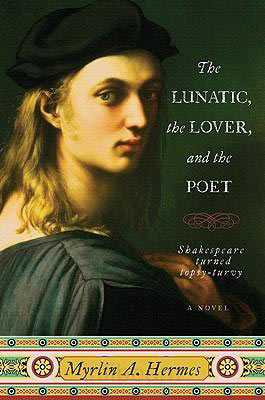More Than Shakespeare Slash: Q&A With Author Myrlin Hermes
Published on March 30th, 2010 in: Books, Culture Shock, Current Faves, Feminism, LGBTQ, Q&A, Teh Sex |By Jemiah Jefferson
The Lunatic, the Lover, and the Poet, the new novel by Portland, Oregon author Myrlin A. Hermes, dismantles some of the best-known works of literature in the English language—the plays and sonnets of good ol’ Willie Shakespeare, most particularly Hamlet—and builds from their parts a unique, steamy, bisexual love triangle between three famous characters.

Horatio, a scholar at Wittenberg University, finds himself head-over-heels in love with the beautiful Prince of Denmark, who wants nothing more than to love Horatio right back. Alas, Hamlet has royal responsibility and a troublingly dark destiny, no matter how much he’d love to shirk both (and ditch bitchy fair-weather friends Rosencrantz and Guildenstern).
Meanwhile, Horatio has been commissioned to write a play by the dark and seductive (and married) Lady Adriane, whose eyes might be nothing like the sun, but whose mind is brilliant, fearless, and modern. She takes quite an interest in Horatio’s passionate love poems—determining that Horatio’s beloved mistress is, instead, a master—and she has her own sensual plans for the young scholar and his secret lover.
Chock-full of wordplay and deft references to the full body of Shakespeare’s work, particularly the sonnets, the novel is a brisk and engrossing read that uses the existing texts the way a painter might use brushes and canvas, creating a work indebted to its source material, but of a very different form altogether.
Hermes’s second novel is much more than just a historical man-on-man romance or a slice of very scholarly slash fan fiction, providing entertainment and surprises for Bard scholars and casual readers alike. (And yes, that’s her real name.)
Popshifter: What inspired you to write this story?
Myrlin Hermes: They say every actor wants to play Hamlet, and perhaps the same is true of authors. Certainly, I’ve found many other writers—Tom Stoppard, John Updike, Margaret Atwood, even Salman Rushdie—have used the play as a springboard for their own creative imaginations. The relationships in the play are so full of ambiguity and unanswered questions, it almost begs you to bring your own back story and interpretation.
I became fascinated with the character of Horatio, who doesn’t talk much in the play, but has a dry, droll wit, and is presented as the only person in the whole play to whom Hamlet always tells the truth. Since he’s the one left alive at the end to “report my cause aright” Horatio becomes the de facto author figure and “narrator” of the tale we have seen. And I tried to play up that idea—the character “Hamlet” we know is as much Horatio’s interpretation of him as the prince himself.
I started seeing their relationship as parallel to that of Shakespeare and the fair young man of the sonnets, whom he promises to immortalize, or to any writer and the character he or she creates. Then the Dark Lady, who seduces both of them, becomes the catalyst—the reader—in whose mind these imaginings come to life.
Popshifter: Who do you think is the true linchpin of the story—Hamlet, Horatio, or Adriane?
Myrlin Hermes: Lady Adriane was fun to write, partly because she’s such a juicy femme fatale—manipulative and wicked, but always three steps ahead of everybody else in the book—and partly because I felt less constrained by the framework of the original text while in her voice. The Dark Lady of the sonnets is the most fascinating female character in all of Shakespeare. She speaks only once; she says “I hate. . . ” then follows it up with “. . . not you.” Everything else we know about her is the poet’s projection.
Pages: 1 2
Time limit is exhausted. Please reload the CAPTCHA.